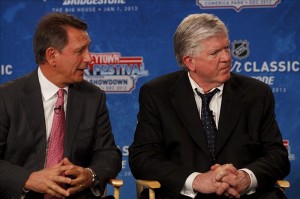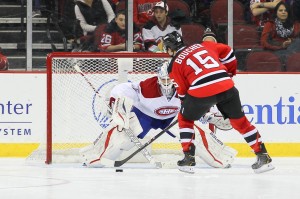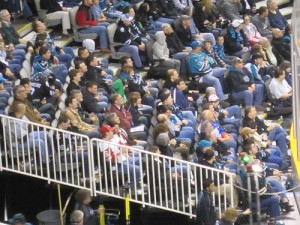Earlier this month, general managers from across the NHL met for their yearly conference in Boca Raton, Florida to discuss different ways to potentially improve the game. This year they came up with a few, including new faceoff regulations and a potential coach’s challenge for certain situations. These rules are not made official until it passes through the competition committee and the NHL Players’ Association Executive Board, and then it must be signed off by the NHL Board of Governors. But the first step happened already, with the GM’s of the league agreeing on the possible rule changes.
In addition to the two aforementioned rule changes, the GM’s agreed on another potential new event in the NHL; the 3-on-3 overtime.

Ken Holland, the general manager of the Detroit Red Wings, has been banging the drums on the eradication of the shootout for a couple of seasons already. While the shootout may be a cutesy event to get fans excited, it’s a gimmick and can be pretty repetitive as the season progresses. The fact that a shootout, on the last game of the season, once decided who made the playoffs one year was the worst sort of playoff qualifying hell imaginable and the Ranger fans know exactly what I’m talking about.
This year, the GM’s agreed. The shootout is a negative. And they must try to limit its impact as best they can.
3-on-3 Overtime
This year, the American Hockey League introduced a new 3-on-3 overtime format. The AHL occasionally serves as a breeding ground for some new NHL rules and this year they were tasked with trying out the new 7 minute sudden-death system. The way they’re doing it is playing the normal 4-on-4 overtime until the first whistle past the 3-minute mark and then switching it up to 3-on-3. If it’s still tied after that, the game goes to a shootout.
GMs recommend 3-on-3 overtime in NHL. Sidney Crosby has long been a proponent. #Penguins
— Shelly Anderson (@_ShellyAnderson) March 17, 2015

The AHL has seen some legitimate success with the new overtime package. When the GM’s decided on the change a couple of weeks ago, the AHL had just 5.7% of games ending in the shootout (vs. 15.6% last season). It’s a tremendous drop and the proven results were just what Ken Holland was looking for.
The GM’s haven’t yet decided if they should do this 7 minute overtime which has the 4-on-4 to 3-on-3 transition halfway through or if they should take up the suggestion by Calgary Flames GM Brad Treliving and adopt the Swedish Elite League system which is just a 5 minute overtime of 3-on-3.
The bottom line is that it appears incorporation of the 3-on-3 overtime is a formality and we’ll just have to wait and see what way the league applies it.
The Problem With 3-on-3
While the new format will indubitably lead to the desired results, the 3-on-3 overtime is far from perfect and has several problems of its own.
Player Exhaustion: The first issue raised, and one that’s mainly NHLPA driven, is that the extra space on the ice will lead to harder skating late in more games. This could lead to higher exhaustion and fatigue for the star players and could really affect them as the season progresses.
Statistical Fluctuation: True, there should be more goals scored with this new format and players will definitely benefit from that (especially since shootout goals don’t count towards a player’s statistics and these 3-on-3 goals will) but it also means that goaltenders will see their save percentage and goals against average drop. Goalies aren’t going to be too happy about that.
Goalie Injuries: One thing you can expect to see with the 3-on-3 overtime is plenty of back-and-forth odd-man rushes. That means that goalies are going to be relied on to make crazy, flexible saves going side-to-side. A goalie could be expected to face multiple difficult stops in the extra frame and, especially after 60 minutes of regulation play, could be exposed to some serious groin or leg strains. This would be bad.
Too Conservative: In today’s over-coached NHL, it would be no surprise to see coach’s throw out two defenceman for the 3-on-3 and instruct them to remain conservative. One bad play or risky pass in the offensive zone and the puck is coming back the other way. The fact that coach’s could still err on the safe side and coach for the shootout means that this new format can still blow up in the NHL’s face.

Too Gimmicky: The problem with the shootout is that it’s an often-boring skills competition that decides who gets an extra point. It also takes the team element out of the game. There are also times when a great game of 65 minutes of competitive hockey has to end in a shootout and it’s essentially the most deflating feeling there is. We occasionally see some nice plays in the shootout but it’s mainly players doing the same leg-kick, forehand-backhand move over and over.
3 on 3 hockey is just as much of a gimmick as a shootout.
— The Suit (@thehockeysuit) March 18, 2015
Sure, the 3-on-3 adds more of a team element to deciding games, but it’s still an uncommon sight in the league and could become the next big gimmick. Fans will quickly realise that, while the play is exciting, 3-on-3 is just a bunch of back-and-forth play with not much defence and a ton of scoring chances. But it’s just as unnatural as the shootout is. If that’s what the 3-on-3 becomes, then it’s only a matter of time before another change is being called for.
They Don’t Know the Format Yet: Whether they choose the 5 minutes of 3-on-3 or go the AHL route and go 7 minutes, first half 4-on-4 and second half 3-on-3, the league still has to sort through this mess and decide what will work best.
Kind of amazing how long things have taken to get to 'yeah 3-on-3 overtime hockey seems superior and sensible'. And we still aren't done!
— Travis Yost (@travisyost) March 17, 2015
Another topic that gets brought up a lot is the way the NHL gives out points. Some fans are sick of the 3 point game and they want to get rid of the “loser point” that gets awarded to the team that goes down in overtime or a shootout. As Tom Mitsos of The Hockey Writers proposed last week, some people suggest that the NHL implements a soccer-style scoring system where a regulation/overtime win counts as 3 points, a shootout wins counts as 2 points, and a non-regulation loss counts as 1.
But what that will do is basically eliminate a lot of the exciting playoff races that we get every single year. People think the loser point is hurting hockey, but really it creates a tremendous amount of parity that leads to exciting playoff races that run late into the season. You start handing out 3 points to winning teams and you create more separation between the top teams and the weaker ones and you get boring, repetitive playoff races by the end of the year.
The Tie
For me, the best thing the league can do is bring back the tie. The NHL had ties before they integrated the shootout back in 2005. The thought was that fans will be happier watching their team get a chance to win than than they would be going home after a draw. It made sense at the time but it’s created a monster and now the NHL is scrambling trying to figure it out.
As Tom Gulitti of The Record noted, there are players who still wonder why the league doesn’t go back to the old days of the tie. While Gulitti was getting Mike Cammalleri’s opinion on the 3-on-3, New Jersey Devils forward Michael Ryder butted in with input of his own.
Ryder, who made his NHL debut in 2003-04 with Montreal, wants to go back to prior to the 4-on-4 days.
“Five minutes 5-on-5. If no one wins, no one wins,” Ryder said. “That’s it. Tie game. See you guys later.”
Los Angeles Kings forward Justin Williams also said earlier this week that he’d like to see the return of ties. (Note: My long-established personal preference has been to get rid of the shootout and go back to regular season games ending in ties. Somehow the league existed just fine with ties prior to the 2005-06 season.)
Cammalleri actually was more intrigued by Ryder’s talk about bringing back ties than the 3-on-3 OT.
“The tie thing is interesting,” he said. But, as he noted, “That’s not even talked about.”
The fact of the matter is that no matter what the NHL does, fans are going to be upset. There are a bunch of legitimate issues that the NHL has to think about in regards to the 3-on-3 and even then it may not be what they’re looking for.
Somehow NHL fans survived and were able enjoy regular season games for more than 85 years with ties. Are today's fans not capable of that?
— Tom Gulitti (@TomGulittiNHL) March 21, 2015
Re-instituting the tie, on the other hand, would be perfectly fine. Some nights neither team deserves a win. A game shouldn’t be tainted because there’s no winner. And the league doesn’t need to add gimmick after gimmick to try to make things fair.